Dates for your Diary
Ongoing – WW1 Exhibition in the Museum
Saturday 3rd February – Coffee Morning – ‘Handle With Care’ – a chance to get hands-on with replica weapons donated by Simon Campbell.
Saturday 3rd March – Coffee Morning – a talk on the History of St David
Saturday 14th April – Coffee Morning – ‘Navy Day’ – all things nautical!
Coming soon
Our museum shop will soon have a selection of Welsh goods for sale. Ideal for St David’s Day and rugby enthusiasts!
January 100 Club
No. 24 Mary Coles £20
No. 47 Bernard Jones £10
No. 20 Judith Williams £5
Museum Society Annual Luncheon
This years luncheon will be held at Llanhilleth Institute on Monday 16th April at 1pm, cost £20.
Guest speaker Mr Jack Hanbury.
Please call at the museum to reserve your place and select your menu choice.
Fundraising December - £923.23
(Including £510 raised at the Christmas Fayre)
Latest Exhibit
Museum member Simon Campbell has very kindly donated a full size replica costume as would have been worn by a Roman Centurion and it is now on display at the museum.
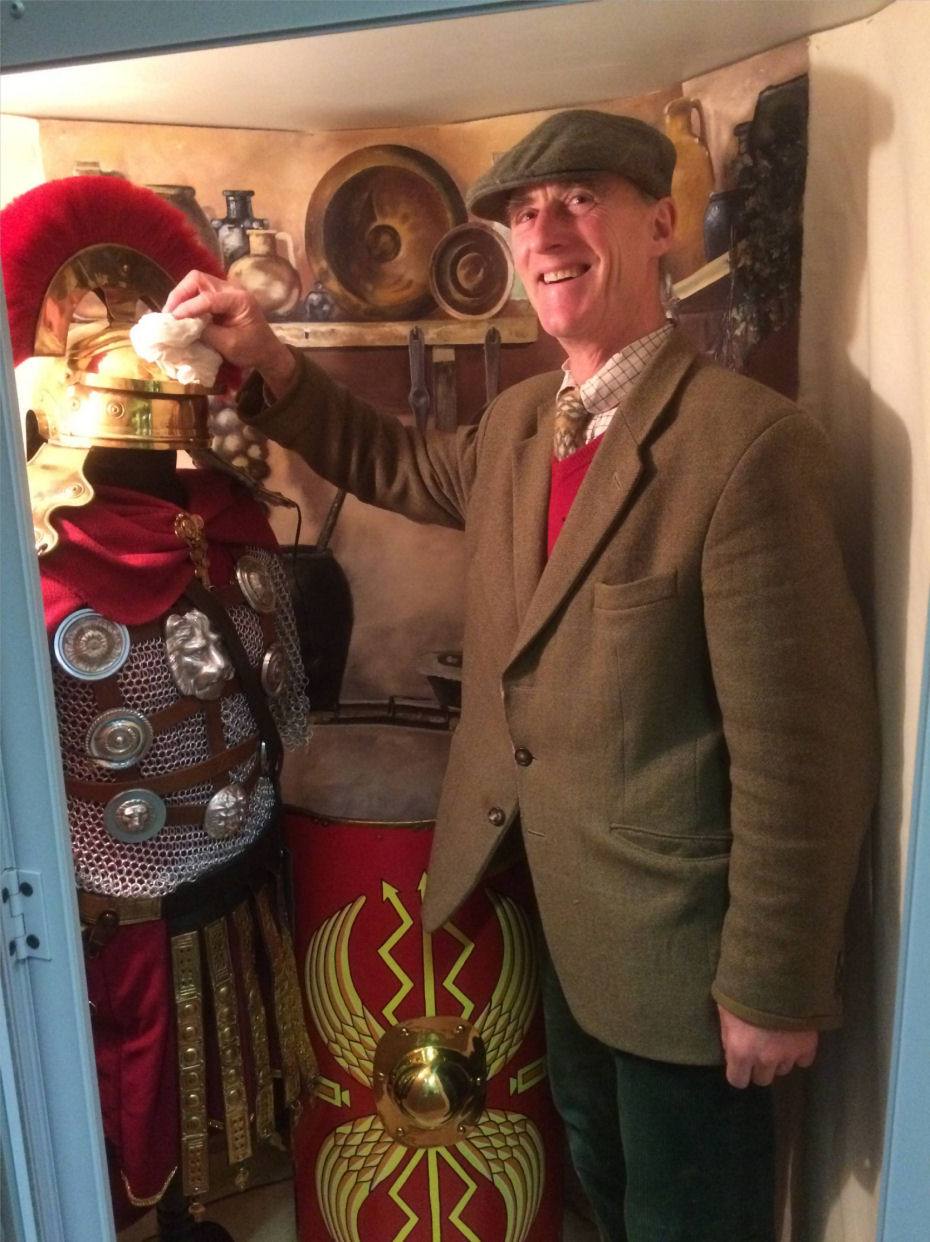
Our new President, Jack Hanbury, adding the final touches to the new exhibit. Read more about our new Patron.
Our New Patron
Mr Jack Hanbury may have only recently become our President but he has long been a familiar figure at the museum. His father, Sir Richard, was a much loved and very involved President of our Society and as his health deteriorated, Mr Jack Hanbury voluntarily took over many of his father's roles, including a keen interest in our museum, regularly calling in and keeping in contact with Peggy and Don Bearcroft, our Chairman and Curator. That interest included an invitation, a couple of summers ago, for a number of our Museum Society members to visit his home and gardens at Clytha, where we were made to feel very welcome. The photograph of Mr Hanbury on page one says more than any of the above words to show his interest in our museum. The photo was taken last month when Mr Hanbury made an impromptu visit to the museum and immediately started helping in a very practical way with the new Roman display. Thank you Mr Hanbury and welcome to our Museum Society.
Jen Price
Jack Hanbury DL DPhil FSA, takes over as our Patron from Sir Richard Hanbury-Tenison, the former Lord Lieutenant of Gwent, who died in August 2017. Mr Hanbury is a former archaeologist, journalist and banker, and currently manages the Pontypool Park Estate, which still owns property near Abertillery, including former granges of the Abbey of Llantarnam, bought from the Morgan family in the C18th. Mr Hanbury’s doctorate was from Oxford University; he is a Deputy Lieutenant of Gwent, a fellow of the Society of Antiquaries, a trustee of the Torfaen Museum Trust, and patron of the Ruperra Castle Trust.
Discovering Picture Postcards
Having a lovely time – wish you were here! Weather perfect, food good. We can see the pier from our bedroom window.
No doubt many of us, if not all of us will have sent a similar message on a picture postcard from our holiday destination. Do we still send them? In today’s digital age the custom has declined - from most places in the world messages and pictures can be sent all over the globe using social media via text; email; facebook, What’sApp, instagram, snap chat…..etc, etc. Last September, the B.B.C. reported that the family-owned U.K publisher J.Salmon, which had been publishing postcards and calendars since 1880, were to close in December 2017 citing people’s ongoing use of social media to be the reason. The number of postcards sold each year is reported to have seen a dramatic slump to about 5 million from 20 million just 25 years ago.
Where did the custom of sending a postcard begin? Apparently the world’s claimed first picture postcard was sent in 1840 by the writer Theodore Hook, to himself, from Fulham in London bearing a penny black stamp. In 2002 the postcard sold for a record £31,750.
In July 1894, British publishers were given permission by the Royal Mail to manufacture and distribute picture postcards, which could be sent through the post. Early postcards were pictures of landmarks, scenic views, photographs or drawings of celebrities and so on. With steam locomotives providing fast and affordable travel, the seaside became a popular tourist destination and generated its own souvenir industry.
 In the early 1930s cartoon-style saucy postcards became widespread, and at the peak of their popularity the sale of saucy postcards reached a massive 16 million a year. In the early 1950s, the newly elected Conservative government was concerned at the apparent deterioration of morals in Britain and decided on a crackdown on these postcards. The main target of their campaign was the postcard artist Donald McGill. In the more liberal 1960s the saucy postcard was revived and later came to be considered by some to be an art form.
In the early 1930s cartoon-style saucy postcards became widespread, and at the peak of their popularity the sale of saucy postcards reached a massive 16 million a year. In the early 1950s, the newly elected Conservative government was concerned at the apparent deterioration of morals in Britain and decided on a crackdown on these postcards. The main target of their campaign was the postcard artist Donald McGill. In the more liberal 1960s the saucy postcard was revived and later came to be considered by some to be an art form.
Postcards continue to be sold at tourist destinations and elsewhere - even at my corner shop. I’m always pleased to see one pop through the letter box. Are you?
Kath Taylor
The Trouble With Cats…!
Did you see the film called A Street Cat Named Bob in the cinema in 2016? If not look out for it on TV as it is well worth seeing. It’s based on the true story of a street busker / recovering drug addict, James Bowen, and a stray cat he adopts (or should I say, adopts him) and who helps him get back on the straight and narrow. In one scene James has spent his last few pounds on anti-biotics from a vet and tries (and fails) to administer them to Bob, and it brought back fond memories of my black cat, Bonnie, whom I lost in February 2016 after a short illness. She was 17 and had had a good life with us and this story is dedicated to her memory and also to any fellow pet owners who have also tried and failed to follow a vets advice….!
One morning in October 2005 I heard a commotion at the cat flap and Bonnie came running in leaving a trail of blood in her wake. On examining her we found that all the fur from her rear left leg had been stripped away and was dragging behind her, exposing the bone. It appears that a neighbour’s cat had gripped her leg as she entered the cat flap and as she pulled away, had ripped her skin off. We immediately rushed her to our local vet’s surgery where an emergency operation was performed to sew her skin back together. We were given a neck collar to put on her to stop her pulling out her stitches and were told to keep her calm, quiet and indoors for ten days, after which time we should return to have the stitches taken out.
So, as soon as we got home, we locked her cat flap, dug out a litter tray from the attic and filled it with fresh litter. She usually did her ‘business’ in the garden but the vet had said to keep her indoors to give the wound a chance to heal and who were we to argue with the vet...?!
Well… we tried, we really did. That evening we did get the neck collar on after a fashion but within ten minutes she had wriggled out of it! She absolutely refused to use the indoor litter tray and raced around the house, upstairs and down, like something demented, pausing only briefly to head-butt the now locked cat flap! Fearful she would pull out her stitches that first night while we slept, we put an elastic bandage on her leg but by morning there was no sign of the bandage! The following day, with the litter tray still unused (just how long can a cat hold itself?), we had to admit defeat and unlock her cat flap.
During those ten days she lived life to the full as usual. She scaled six foot fences, went hunting and caught a mouse which she brought in to play with before eating it and leaving the remains for me to almost step on with my bare feet, and at every opportunity she would pull, lick and tug at her stitches if she thought we weren’t looking, and when we challenged her she would stop and look at us like butter wouldn’t melt! (You talking to me?)
When we returned to the vet’s surgery ten days later and the vet asked how she had been we said, tongue in cheek, “no problem”. We held our breath and had our fingers crossed behind our backs as he took the stitches out, fully expecting it to all fall apart, however, to our utter disbelief it had healed!! We thanked the vet and left but said nothing of Bonnie’s antics! Then, after losing Bonnie in February 2016, we received a lovely sympathy card from our vets surgery so I sent a thank you letter back and confessed all! I hope it made them smile!
Sally Murphy
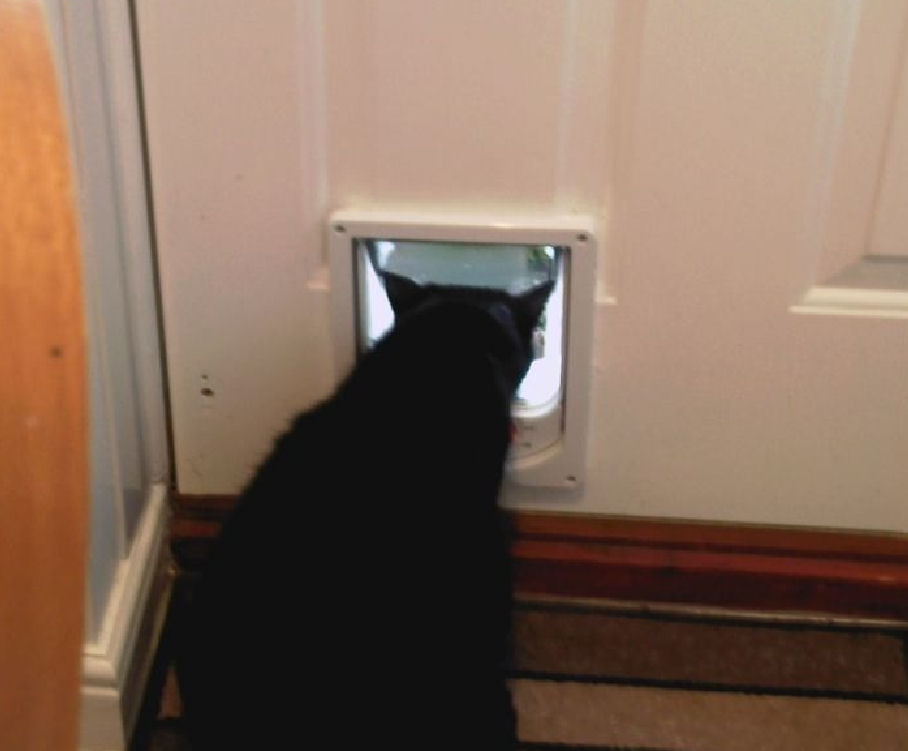
Bonnie taking a rain check!
Do you have any funny pet stories?
Email me at
sallymurphy@talktalk.net
And remember…
- Dogs come when they’re called; cats take a message and get back to you.
- Dogs treat humans like Gods; cats believe they are Gods.
- Dogs have masters, cats have staff.
- Women and cats do as they please and men and dogs would do well to remember this!
- Dogs are eager to please; cats do as they please.
- Everyone needs a dog to adore them and a cat to bring them back to reality.
- The motto of the cat is that no matter what you’ve done, always try to make it look like the dog did it…
And finally…
- There is no snooze button on a cat who wants breakfast!
Museum Matters
Links
In our museum are a number of artefacts which are not only related to each other but also to one man.
The artefacts are as follows: Minute Books, signing on books, postcards depicting Maggie Thatcher and Lord Robbins being swallowed by a dragon, posters asking people to donate to the miners’ food fund, the N U M Banner for local mines and a tin of ham donated by the people of Holland to the miner’s food fund.
As you have probably guessed these items are related to a mine (Six Bells) and the Miners strike of 1996. The man was the late Councillor Jimmy Watkins of Six Bells. I first met Jim when I started as an apprentice electrician and he was an electrician at Six Bells.
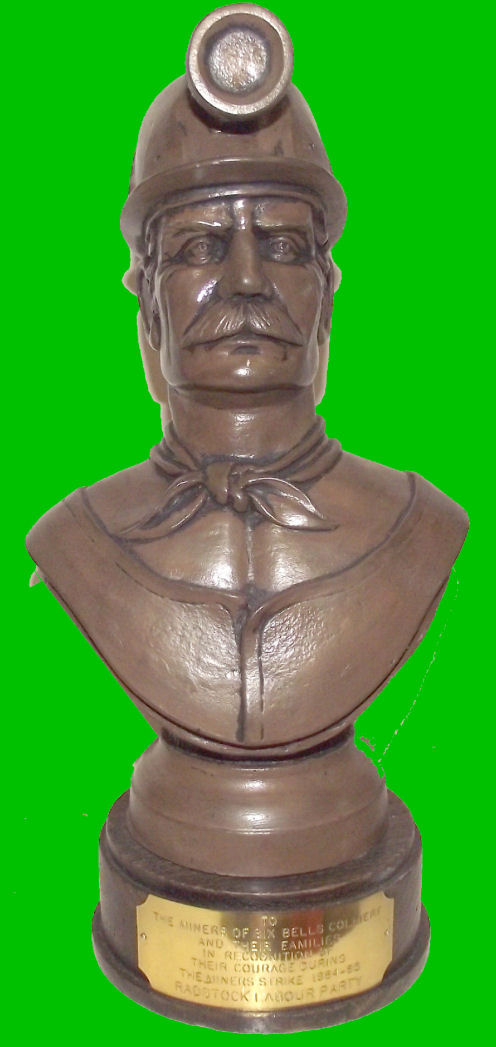 Jim had a lucky escape on the day of the Disaster; the Engineer Jack Taylor had given him an electrical job in W District. After Jim had gone down the pit the engineer changed his mind wanting Jim to go instead to H district on a different job. The only way Jim could be contacted was to phone the 75hp haulage asking the engine driver to pass the message on. It would mean walking back out and another long walk in the opposite direction to H district. The explosion occurred that day in W district and it was not until all the men had been withdrawn from the mine that the Engineer waiting at the surface was relieved to see Jim emerge with other men. He had received the message and acted on it.
Jim had a lucky escape on the day of the Disaster; the Engineer Jack Taylor had given him an electrical job in W District. After Jim had gone down the pit the engineer changed his mind wanting Jim to go instead to H district on a different job. The only way Jim could be contacted was to phone the 75hp haulage asking the engine driver to pass the message on. It would mean walking back out and another long walk in the opposite direction to H district. The explosion occurred that day in W district and it was not until all the men had been withdrawn from the mine that the Engineer waiting at the surface was relieved to see Jim emerge with other men. He had received the message and acted on it.
Later Jim became a shift charge hand with other electricians on his shift of which I was sometimes one.
During the off shifts Jim was responsible to seeing that the work given by the Electrical Engineer was carried out and for all the electrical apparatus in the mine.
Jim became Craftsman’s representative  on the Six Bells Lodge, (Union) and during the strikes his ability as an organizer was utilized. During the year long miners' strike of (1984–85) he was responsible for the distribution of food in the Food Fund, the depot for this was at Hillside Crumlin, this was sometimes a thankless task. Food was donated from many places, a tin of ham was sent from the people of Holland.
on the Six Bells Lodge, (Union) and during the strikes his ability as an organizer was utilized. During the year long miners' strike of (1984–85) he was responsible for the distribution of food in the Food Fund, the depot for this was at Hillside Crumlin, this was sometimes a thankless task. Food was donated from many places, a tin of ham was sent from the people of Holland.
Miners from Six Bells travelled around the country collecting for the strike fund and in Somerset they were asked to sing! Afterwards they were presented with the bust of a Radstock miner.
As the strike ground on feelings grew bitter and divisions occurred between the miners themselves. An electrician who helped deliver the food to those in need was so incensed by what the wife of what another was saying about him that he went to their house threatening to take them to court for libel if they persisted in their malicious gossip.
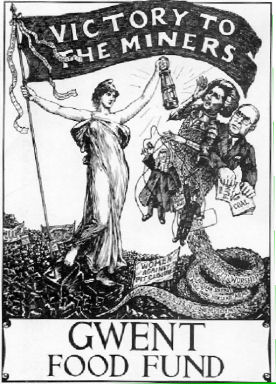 One night a disgruntled person or persons threw a breeze block through Jim’s kitchen roof into his scullery! It was a long time before things returned to normal amongst the men. The strike ended and the feared pit closures continued with a vengeance.
One night a disgruntled person or persons threw a breeze block through Jim’s kitchen roof into his scullery! It was a long time before things returned to normal amongst the men. The strike ended and the feared pit closures continued with a vengeance.
Jimmy Watkins continued his work with the NUM and on the annual remembrance Service for the victims of the disaster at St John’s church he would read out the names of the victims. Jim became a Borough Councillor for Six Bells Ward and when it was decided to replace the mining monument at Six Bells with Guardian he worked with the committee to obtain their objective.
The Archbishop of Canterbury opened the monument and as was fitting Jimmy read out the names of the victims, he continued to do this until ill health prevented him.
Jim died on 3rd January 2018 his service was held at Zion Miners Chapel Llanhilleth, it was packed as you would expect. I saw men who had been electrical apprentices as I said to Ray Cecil, “if there is a breakdown we have plenty to cover it”.
The atmosphere in the chapel was electric! The service started with a recording of; “You can’t touch me I’m part of the union, until my dying day!” It was a beautiful service ending with the hymn, Calon lan.
As Peggy and I were making our way out Jim’s son Kelvin leaned forward and whispered in my ear, “there is a spare Sunday night shift going if you want one”.
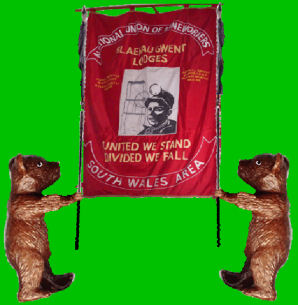 I was emotional at the time but when I looked him in the face we both laughed together. Only a Six Bells electrician would appreciate this, I know Jim would.
I was emotional at the time but when I looked him in the face we both laughed together. Only a Six Bells electrician would appreciate this, I know Jim would.
Don Bearcroft, Curator


